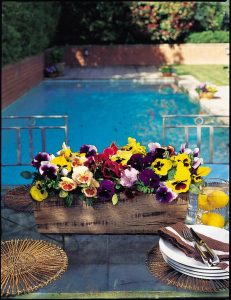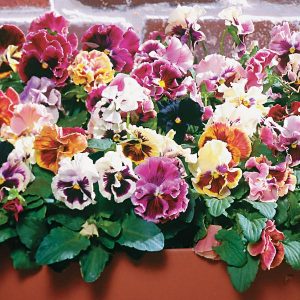Legend has it that pansies could transfer the thoughts of sweethearts without a word being spoken. They have been in fashion since Victorians supposed them to be the flowers of lovers, and long a popular ingredient in “love potions”. They have appeared in the writings of many authors, including D. H. Lawrence, Hawthorne, Wordsworth, and Shakespeare.
 Pansies remain the most popular mountain flower at the garden center. Daily, trunk loads of these flowers are carried home by gardeners to perk up otherwise dull spring landscapes. The dainty gold, purple, blue, and red blossoms easily fulfill their intended purpose
Pansies remain the most popular mountain flower at the garden center. Daily, trunk loads of these flowers are carried home by gardeners to perk up otherwise dull spring landscapes. The dainty gold, purple, blue, and red blossoms easily fulfill their intended purpose
As members of the viola family, pansies technically are perennials but are best used as annuals or biennials. Because they deteriorate in the heat of summer (unless shaded) they should be used in the cooler seasons of spring, fall, and winter. During their first spring season they tend to be magnificent, so mountain gardeners plant them as cheery bright spots in spring gardens, replacing them with heat tolerant plants for summer.
Pansies are planted in September and October to give us color throughout the winter. Freezes shut them down for a short period in January, but as soon as temperatures moderate, they spring back to life with even more vigor and bloom. Tough little plants, they are perfectly suited in rock gardens and containers.
Over the years I have perfected the germination of pansies, a process not as simple as scattering a few seeds in a pot of soil and waiting for that bit of green. After sowing the seeds, sprinkle about 1/8″ of seed-starting mix over them, and cover the flats with a board or cloth. Pansy seeds require 10 – 20 days of total darkness for germination. Check on their progress frequently. Move the seedlings to a cool, bright area as soon as they emerge, taking care to keep the seedlings moist. They can be transplanted as soon as they have two sets of true leaves.
But don’t worry if you’re not into starting seedlings. Pansies are the first flowers to show up at local garden centers in spring, and are very affordable. Because mountain spring weather can turn cool unexpectedly I suggest planting only 4-inch and 1-gallon sized pansies early in spring, staying away from the smaller 6-packs until after April. The additional size and maturity of the larger plants makes them more robust should a final winter blast hit the gardens.
 Pansies like sunny, moist conditions. They bloom best when there is ample water provided by rich soils in raised beds and container gardens. They are heavy feeders, so for maximum color and fragrance feed them twice a month with water soluble ‘Flower Power 54’. Deadheading promotes more flowers that will bloom for longer periods of time. Snails and slugs like pansies, but they are easy to overcome; slug bait is the means to eliminate these slimy insects. Aphids also are attracted to pansies, but they can be exterminated with ‘Home Harvest’ insect spray.
Pansies like sunny, moist conditions. They bloom best when there is ample water provided by rich soils in raised beds and container gardens. They are heavy feeders, so for maximum color and fragrance feed them twice a month with water soluble ‘Flower Power 54’. Deadheading promotes more flowers that will bloom for longer periods of time. Snails and slugs like pansies, but they are easy to overcome; slug bait is the means to eliminate these slimy insects. Aphids also are attracted to pansies, but they can be exterminated with ‘Home Harvest’ insect spray.
Stay away from harsh pesticides if you plan to use your pansies in the kitchen. Yes, the colorful blooms are quite edible and make pretty garnishes for salads and desserts. With a little imagination, pansy blossoms make beautiful additions to spring meals, even if only as decorations. Blossoms frozen in ice cubes add a bit of fun to any summer gathering.
Pansies’ monkey-face-like markings long have charmed people and contributed to their interesting history. Their resilient determination to bloom in just about any conditions makes them excellent choices as spring bloomers. Spring is here! It’s time for pansies!
Until next week, I’ll see you in the garden center.
Ken Lain can be found throughout the week at Watters Garden Center, 1815 W. Iron Springs Rd in Prescott, or contacted through his web site at www.wattersgardencenter.com or Facebook page www.facebook.com/WattersGardenCenter .

